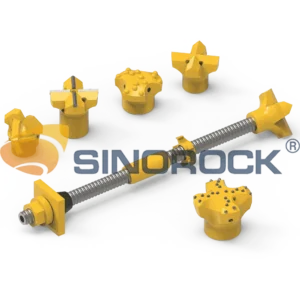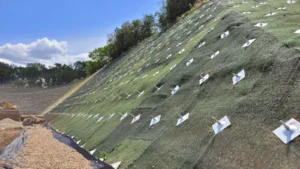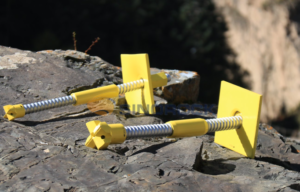Can Self-Drilling Rock Bolts Be Used as Soil Nails?
Soil nails are a widely adopted support system in geotechnical applications, including excavations, slope stabilization, and tunneling. Traditionally, steel is the primary material for soil nails, but it faces limitations when applied to loose or collapsible geological conditions. In such challenging scenarios, self-drilling anchor systems offer a reliable solution. But how effective are self-drilling rock bolts as soil nails?
This article delves into the application of self-drilling anchor systems as soil nails, detailing their construction methods, advantages, and distinctions from traditional soil nails.
The Self-Drilling Anchor System as a Soil Nail: Construction Method
Self-drilling anchor systems combine drilling, grouting, and anchoring into a single efficient process, making them well-suited for use as soil nails in challenging geological conditions. Below is a detailed construction process:
1. Components of the Self-Drilling Anchor System
The system comprises:
- Drill Bit: Facilitates drilling and initial penetration.
- Anchor Bar: Acts as both the drill rod and the structural reinforcement.
- Centralizer: Ensures the anchor bar remains centered within the borehole.
- Coupler: Connects multiple bars for extended lengths.
- Plate and Nut: Transfers tensile forces to the rock or soil surface.
2. Construction Preparation
- Site Assessment: Evaluate the geological conditions to ensure suitability for self-drilling anchors.
- Equipment Inspection: Check the integrity of drill bits, anchor bars, and the drilling rig.
- Site Leveling: Ensure a stable and leveled construction platform.
3. Drilling and Grouting Process
- The anchor bar serves as the drill rod and is advanced into the soil with simultaneous drilling and grouting.
- The grout exits through holes in the drill bit, filling voids and binding the surrounding soil or rock.
- This combination of drilling and grouting creates a robust bond, enhancing the system’s anchoring capacity.
4. Application of Prestressing Force
To stabilize the structure effectively:
- Install plates and nuts on the rock or soil surface.
- Tension the anchor bar to introduce a prestressing force, allowing elongation within its free length.
- This process transmits compressive stress to the surrounding rock or soil, improving stability.
Differences Between Self-Drilling Anchor Systems and Traditional Soil Nails
The self-drilling anchor system distinguishes itself from conventional soil nails through several key differences:
1. Construction Process
- Soil Nails: Traditional soil nail construction often requires casing to stabilize the borehole in loose or collapsible soils. Reinforcement is inserted into the casing before grouting.
- Self-Drilling Anchor System: Combines drilling and grouting in a single operation, eliminating the need for casing and making it more efficient in fractured and unstable geology.
2. Vibration and Noise
- Soil Nails: Installation involves steel pipe impact, which generates significant vibration and noise. This can destabilize the surrounding soil and reduce load-bearing capacity.
- Self-Drilling Anchor System: The simultaneous drilling and grouting process minimizes vibration and noise, preserving soil stability.
3. Soil Nail Length
- Traditional Soil Nails: Typically limited to 15 meters in soft soils, and even shorter in sandy or silty conditions due to high resistance during installation.
- Self-Drilling Anchor System: Achieves greater penetration depth due to its low drilling resistance, enabling enhanced support in deep and unstable strata.
Advantages of Using Self-Drilling Anchor Systems as Soil Nails
1. High Efficiency
The integration of drilling, grouting, and anchoring reduces the time and labor required for installation.
2. Superior Adaptability
Self-drilling systems are well-suited for loose, fractured, or collapsible geological conditions where traditional soil nails struggle.
3. Enhanced Load Capacity
The combination of grout and surrounding soil or rock creates a robust bond, delivering higher load-bearing capacity compared to conventional soil nails.
4. Improved Stability
The application of prestressing force ensures that compressive stresses are evenly distributed, enhancing the overall stability of the structure.
5. Minimal Environmental Impact
Reduced vibration and noise make self-drilling anchor systems more environmentally friendly and suitable for urban or ecologically sensitive areas.
Applications of Self-Drilling Anchor Systems as Soil Nails
1. Slope Stabilization
Self-drilling anchor systems are commonly used in soil nail walls to resist downward forces and prevent slope failures.
2. Excavation Support
The system is effective in retaining walls and deep excavations, providing reliable support in challenging soil conditions.
3. Tunnel Construction
In tunneling projects, self-drilling anchors act as reinforcement in unstable or fractured rock masses.
4. Retrofitting and Repair
These systems are ideal for strengthening existing structures, such as retaining walls or embankments, that have weakened over time.
Industry Trends and the Future of Self-Drilling Anchor Systems
The use of self-drilling anchor systems in geotechnical engineering is gaining traction due to advancements in construction techniques and the growing need for efficient solutions in complex geological conditions. Key trends include:
- Innovative Materials: Development of corrosion-resistant and higher-strength materials for anchor bars.
- Automation: Integration of automated drilling rigs to enhance precision and reduce manual labor.
- Sustainability: Adoption of environmentally friendly grouting materials and practices to minimize ecological impact.
Conclusion
Self-drilling anchor systems offer a practical and efficient alternative to traditional soil nails, particularly in loose, fractured, or collapsible geological conditions. Their ability to combine drilling, grouting, and anchoring into a seamless process ensures superior performance and adaptability across various geotechnical applications.
As the industry continues to innovate, self-drilling anchor systems are set to play an increasingly significant role in geotechnical engineering. Companies like Sinorock are at the forefront, providing cutting-edge solutions and technical expertise to meet the demands of modern construction projects.
For inquiries or further assistance, feel free to reach out to Sinorock, where experienced engineers are ready to help with your geotechnical challenges.





